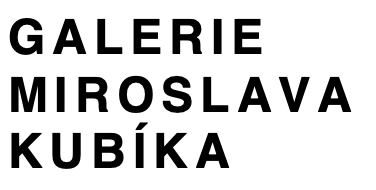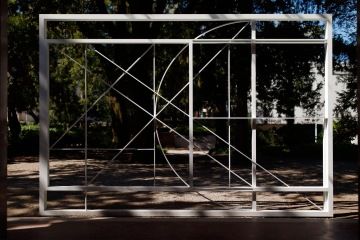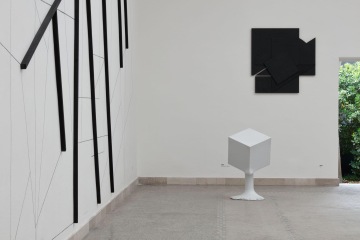Stanislav Kolíbal
*1925, Orlová, Czech Republic

ABOUT THE ARTIST:
Stanislav Kolíbal is undoubtedly one of the most important protagonists of Czech and international art of the second half of the twentieth century, with an overlap, for the author's respectable age, into the twenty-first century. Born in Orlová in the Těšín region, he moved to Ostrava with his parents after the occupation of this region. At the end of the war, he was assigned to work in the Ostrava mines. Perhaps it was these early experiences that brought an existential subtext to his later, otherwise seemingly quite rationally geometric work. Kolíbal has been inclined to fine arts since the early years. From the age of thirteen, he modeled and drew. In 1943 (at the age of eighteen) he exhibited at a group exhibition at the House of Arts in Ostrava. The decision to become an artist was unequivocal, so Kolíbal decided to study right in the center of events - in Prague.
Almost from the beginning, Kolíbal's work has been accompanied by an interest in the geometric solution of matter and space. His sculptures and objects are characterized by the use of minimal resources, but their testimony is considerable. The critic Tomáš Pospiszyl aptly called his work when he speaks of Kolíbal as the creator of "emotional geometry". The author's work is not expressively cold: it is based on the perception of the complementarity of conflicting values, such as stability and lability, order and chaos, duration and transience, origin and extinction. Kolíbal's work is thus a mirror of his personal emotions, evoked by the world around him and society. Kolibal's work touches on the basic transcendent values of human life. And although this character of art, in the sense of Chalupecký's emphasis on the transcendental message of a work of art, seems to be overlooked by many today, Kolíbal managed to gain admiration even among many renowned young artists. I think that this is a great satisfaction not only for the artist himself, but also for the whole Czech art of the second half of the twentieth century.
STUDIES:
- 2005 State Award of the Czech Republic for services to the state in the field of culture and art
- 1990-93 Professor of the Academy of Fine Arts in Prague awards
- 1973-80 ban on export and sale of works, ban on exhibitions
- 1953 Acquires a studio in Prague 7, Nad Královskou oborou 23 and marries the sculptor Vlasta Prachatická. He gets acquainted with the circle of artists of Umělecká beseda.
- 1951–1954 During his studies, he collaborated with theaters in Ostrava, Opava and the National Theater in Prague. After graduation, an external teacher of stage technology
- 1951–1954 Academy of Performing Arts in Prague, field of scenography with prof. František Tröstra
- 1945–1951 Academy of Arts, Architecture and Design in Prague, studio of prof. Antonín Strnadel
- from 1945 he began working for newspapers and books. He drew, for example, for the newspaper Svět práce, worked on covers and book illustrations. Kolíbal then devoted his entire life to illustration work.
- In 1944 he was deployed for forced labor in the Ostrava mines
- 1938 After the occupation of Těšín by the Polish army, he moved with his parents to Ostrava, where he continued his studies at the grammar school, drawing and modeling.
STUDY STAYS:
- 1968 Resident scholarship of the Karolyi Foundation, Vence, France;
- 1969 Ford Foundation Scholarship;
- 1988-89 DAAD Berlin Scholarship;
- 1992 Residence scholarship to Atelier Calder, Saché, Le Carroi, France.
EXHIBITIONS:
- 2012: Zdeněk Sklenář Gallery (S), Prague / Prague Castle Riding School, Prague
- 2011: Dynamo Design, Prague / White Gallery, Osík u Litomyšle / Brno Gallery, Brno
- 2010: White Gallery, Osík u Litomyšle
- 2009: House of Arts, Ostrava / Pilsen City Gallery, Pilsen
- 2008: Zdeněk Sklenář Gallery, Prague
- 2007: Woxart Gallery, Prague
- 2006: Walter Storms Gallery, Munich
- 2005: East Bohemian Gallery, Pardubice / Bratislava City Gallery, Bratislava / National Gallery, Prague
- 2004: Moravian Gallery (Part I), Brno / Moravian Gallery (Part II), Brno / Gallery at the White Unicorn, Klatovy
- 2003: Egon Schiele Art Center, Český Krumlov
- 2002: House of Arts, České Budějovice
REPRESENTATION IN COLLECTIONS:
- Museum of Modern Art, New York
- Metropolitan Museum of Art, New York
- Solomon R. Guggenheim Museum, New York
- Brooklyn Museum of Art, New York
- Center Georg es Pompidou, Paris
- FRAC Brittany
- Museum of Grenoble
- St. John's Museum Croix, Poítiers
- Tate Gailery, London
- Museum Modemer Kunst, Vienna
- Albertina, Vienna
- Peter Ludwig Museum, Budapest
- Museum of Art, Łódž
- Kunstmuseum Winterthur
- Patentamt, Munich
- National Gallery, Prague
- Galerie hl. of the city, Prague
- Czech Museum of Fine Arts, Prague
- Moravian Gallery, Brno
- Galerie Benedikta Rejta, Louny
- Aleš South Bohemian Gallery, Hluboká nad Vltavou
- Museum of Art, Olomouc
- Gallery of Fine Arts in Ostrava
- West Bohemian Gallery, Pilsen
- Art Gallery, Karlovy Vary
- North Bohemian Gallery of Fine Arts, Litoměřice
- Regional Gallery, Liberec
- Gallery of Modern Art, Roudnice nad Labem
- Gallery of Modern Art, Hradec Králové






